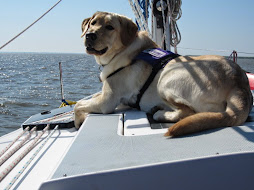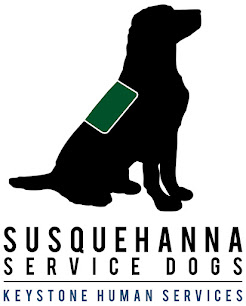Do you enjoy hiking,
visiting a neighbor’s fenced-in yard, or just want the safety insurance of a
great recall? Our director, Nancy Fierer, explains how to train a reliable
recall.
I enjoy taking long walks or hikes in remote areas with my
dogs off leash. It’s dog heaven for them to explore smells, take giant runs,
roll, leap for joy, and possibly swim. It also lets me enjoy the scenery
without having to work on loose leash walking. Then, of course, there’s my
house. I live on five acres, which is located .6 miles from the road. I’m lucky
that I can open the door and let my dogs free. (However, if I feel that danger
is nearby, my dogs are always on leash.)
It takes a reliable dog to do any of this—a reliable,
trained dog with a solid recall. I start training recalls when the dog is very
young, but the training methods also work with older dogs.
Most dog owners expect their dogs to come when called,
simply because they told them to and the dog should listen. But let’s put this
into perspective. When you’re calling your dog, the dog is out there in the
world, making their own decisions. You ask the dog to come, and the dog decides
whether to come to you of its own freewill. Usually, when you call your dog,
you’re competing with many other interesting things, such as squirrels, great
smells, birds, other dogs, other people, noises, etc. If you’re asking your dog
to ignore all those interesting things and come directly to you, you better be
prepared to make it worth their while so your dog wants to continue to come to
you.
There are several
rules that must be followed:
- Every time you call your dog, whether you're inside or outside, the dog gets reinforced. Every time.
- The reinforcer must be something really good because things in the environment are competing for your dog's attention. A reinforcer is defined as something the dog wants enough to repeat the behavior that resulted in the first reinforcement.
- If it takes a long time for your dog to respond or if they actively ignore you, you still need to reinforce them when they actually come to you. Setting criteria to improve latency (speed of response) should only be done in a controlled environment.
- A reliable recall needs to be practiced over and over and reinforced during the lifetime of the dog.
SSD has guidelines on how to train a reliable off-leash
recall using the cue “come.” These directions are very specific and helpful,
especially with an older dog or when the dog is in a new or challenging
environment.
In order to get a solid recall, you need to commit to
practicing at least three times a day. The more you practice, the better and
faster the results will be. Tip: Practice right before you feed your dog, so
they’re really hungry. You can even use recall practice as a way to feed your
dog its meals.
Definition
The dog comes quickly and immediately when called, either on
or off-leash and in any situation.
Cue
Verbal: “come”
How to Train It
Equipment Needed
1 long rope at least 100 feet long (for use outside)
Treats your dog thinks are awesome
Someone to hold the end of the rope
1 hungry dog
Start by working in a place with minimum of distractions,
like your backyard. Attach the long rope to your dog’s leash and allow the dog
to have 20 feet of rope. Wait until your dog starts paying attention to
something else. When you feel your dog is sufficiently distracted, say your dog’s
name loud and clear and then say “come.” Have your treats ready, and as soon as
your dog decides to come click and praise them. When they get to you, take out
a handful of bite-sized treats and feed them to your dog one at a time for 30
seconds, praising them the entire time.
This is the “fine dining” method of reinforcement. With
clicker training, we typically only give the dog one treat. The dog usually
inhales the treat and it’s over quickly. But with fine dining, the sheer number
of treats makes a huge impression on the dog’s brain and they think “Wow! How
do I make this happen again?” They’re much more likely to come the next time
they’re called.
If your dog doesn’t come to you when you call, don’t yell or
get angry. Just hold on to the rope, count to 5, and try again. Even if it
takes your dog a long time to decide to come, you still need to reward the dog
for ultimately making the right decision.
After your dog has come, let them turn their attention
elsewhere, then call them to come again, repeating the fine dining experience
when they do. Remember to wait until your dog is no longer interested in you
before calling their name. Slowly increase the amount of time between each
recall, allowing your dog to get more and more distracted. When your dog is
doing it perfectly every time, it’s time to increase the amount of rope to 40
feet. Keep increasing the rope length until the dog has the entire 100 feet of
rope.
Once the dog has a perfect recall on the 100 foot rope, it’s
time to try moving around the yard and calling your dog from different
locations. Move to your front yard to practice or to go a park. Practice a lot!
If your dog doesn’t come even once, you’re not ready to move on to the next
step.
Now it’s time to take away the rope. You may want to start
in a large fenced in or partially fenced in area. Practice a few times with the
rope, just to warm your dog up. Then drop the rope. Let your dog wander away,
then call them and give them lots of treats.
After several sessions of just dropping the rope, you’re
ready to take the rope away completely. Continue practicing as you have been.
If your dog doesn’t come to you, don’t panic! Count to 5 in your head, then
call them again. If the dog still doesn’t come, turn your back to the dog and
move away. Never yell and do not chase the dog. Your dog will eventually come
to you, and when they do, give them lots of treats and go back to practicing
with the rope.
If you’re patient and practice every day, your dog will have
a GREAT recall.
Recalls Inside your
Home or Other Buildings
Remember, you will need to call your dog in many situations,
not just outdoors. Make sure you practice inside, too. You won’t need the rope,
but make sure you have lots of treats for fine dining. Every time you call your
dog and they come to you, you’ll need to give them lots of treats.
Notes about Reinforcers
The treats you use as reinforcers must be more exciting to
your dog than the things in the environment. This is very important because if
your dog doesn’t think your treats are better than the great smells in the
grass, they’re not going to come to you.
Dog food is good. It’s what we use on a daily basis for
treats. Dog treats are even better. Real, cooked meat is better still, and people
food (like a hamburger or hotdog, bun and all) may be best of all. Use whatever
your dog really likes, but don’t think that a carrot is as good as a warm,
juicy steak. Also, variety is always good, and challenging environments need
highly reinforcing rewards.
If you don’t have any treats with you, a “Good dog!” and a
nice pet might work once in a while, but don’t rely on it. You want build a
good history with your dog so they associate the word “come” with something
really great (like lots of tasty treats).
Stories from the
Fierer House
A reliable recall is so important to my lifestyle, so I’ve
built up a lot of experience training this behavior. I’m highly motivated to be
consistent throughout the lives of my dogs. This is key to a great recall.
At one point, I had a young dog in my house, SSD Terra, and
my grandchildren were here for a visit. They used my van, went to McDonalds, and
returned. When I was cleaning out the van later that day, I found half a
hamburger and realized that it would be a huge training reward. Terra was
outside and totally focused on playtime with the children. I took the burger
inside, then stepped outside to call her. She came reluctantly and then WOW!—she
got a burger, bun and all, and she couldn’t believe her luck. Her recall was
spectacular for months afterward.
On a recent hike, my three dogs were off leash on a deserted
trail. Along came a hiker with a dog on a leash. I called the dogs over, and
they easily stayed while the dog passed by. They had done over 15 recalls with
treats during the first 45 minutes of the hike, so when I called them because
of the hiker and dog, they came just as they had practiced. The message here is
to reinforce your dog every time. A reliable recall needs to be practiced forever.
Even at 11 years old, Gideon will enter the house and stand
in front of the pantry door (3 steps away from the front door). Inside is a can
with treats—recall treats—that they get every time I call them into the house.
Terra will even run out the door and run back in to stand by the pantry as if
to say “Look, I came back. Don’t you remember calling me?”
Sometimes you need to change the reinforcers throughout the
dog’s life. When SSD Meade, one of our breeding dogs that I raised, turned two,
he discovered girls and other delights, and his recalls were suffering. I
changed his recall treats to freshly cooked chicken and sometimes steak that
was slightly warmed. After several sessions, he improved, but I still throw in
a great surprise every now and then. Sometimes on the trail, he is very
rewarded with just a kibble or two and an “okay” to release him to go sniff and
explore again. As his arousal level or energy level returns to normal, the “okay”
release loses its power and I need to give him better treats. Reinforcers can
be variable, depending on the dog’s mood.
Take the time to be consistent. Start with great treats, and
enjoy the progress you make.









No comments:
Post a Comment